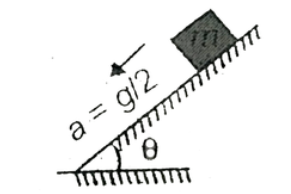A balloon of mass m is descending down with an acceleration How much mass should be g2 removed from it so that it starts moving up with same acceleration?
12J
32J
94J
92J
To solve the problem step by step, we will analyze the forces acting on the balloon in both scenarios: when it is descending and when it is ascending.
Step 1: Understand the forces acting on the balloon
The balloon has a mass m and is descending with an acceleration of g2. The force due to gravity acting on the balloon is given by:
Fg=mg
Step 2: Set up the equation for the descending balloon
When the balloon is descending, the net force acting on it can be expressed as:
F−mg=−ma
Here, a=g2 (downward acceleration), so:
F−mg=−m(g2)
Step 3: Rearranging the equation for the descending balloon
Rearranging the equation gives:
F=mg−m(g2)
F=mg−mg2
F=mg2
Step 4: Set up the equation for the ascending balloon
Now, let’s consider the case when we remove a mass x from the balloon. The new mass of the balloon becomes m−x. The balloon now moves upward with the same acceleration g2. The net force equation for the ascending balloon is:
F−(m−x)g=(m−x)(g2)
Step 5: Rearranging the equation for the ascending balloon
Rearranging this equation gives:
F=(m−x)g+(m−x)(g2)
F=(m−x)g(1+12)
F=(m−x)(3g2)
Step 6: Equate the forces from both scenarios
Since we have two expressions for F:
mg2=(m−x)(3g2)
Step 7: Cancel g from both sides
Dividing both sides by g2:
1=3(m−x)
Step 8: Solve for x
Expanding and rearranging gives:
1=3m−3x
3x=3m−1
x=m−13
Step 9: Final answer
Thus, the mass that should be removed from the balloon is:
x=2m3
Fg=mg
F−mg=−ma
Here, a=g2 (downward acceleration), so:
F−mg=−m(g2)
F=mg−m(g2)
F=mg−mg2
F=mg2
F−(m−x)g=(m−x)(g2)
F=(m−x)g+(m−x)(g2)
F=(m−x)g(1+12)
F=(m−x)(3g2)
mg2=(m−x)(3g2)
1=3(m−x)
1=3m−3x
3x=3m−1
x=m−13
x=2m3
Topper's Solved these Questions
Similar Questions
A balloon with mass m is descending down with an acceleration a (wherea<g) . How much mass should be removed from it so that it starts moving up with an acceleration a?
View SolutionA balloons of mass M is descending at a constant acceleration α. When a mass m is released from the balloon, it starts rising. With the same acceleration α. Assuming that its volumes does not change, what is the valule of m?
View SolutionA balloons of mass M is descending at a constant acceleration α. When a mass m is released from the balloon, it starts rising. With the same acceleration α. Assuming that its volumes does not change, what is the valule of m?
View SolutionA balloon with its contents weighing 160 N is moving down with an acceleration of g/2 ms−2 . The mass to be removed from it so that the balloon moves up with an acceleration of-g/3 ms−2 is
View SolutionA balloon of mass 10 kg is raising up with an acceleration of 20ms−2. If a mass of 4 kg is removed from the balloon its acceleration becomes ( take, g=10ms−2)
View SolutionA ballon of mass m is rising up with an acceleration a show that the fraction og weight of balloon that must be detached in order to double its acceleration , assuming the upthrust of air to remain the same

View SolutionA block of mass 2 kg rests on an inclined plane which makes an angle of 30∘ with the horizontal. The coefficient of friction between the block and the surface is √3/2. (i) What force should be applied on the block so that it moves down without any acceleration ? (ii) What force should be applied on the block so that it moves up without any acceleration ? (iii) Calculate the ratio of the powers in the above two cases if the block moves with uniform speed in both the cases.
View SolutionA balloon of mass M descends with an acceleration a0. The mass that must be thrown out in order to give the balloon an equal upwards acceleration will be
View SolutionA block of mass m slides down a rough inclined plane with an acceleration g2

View SolutionWhen an empty lift is moving down with an acceleration of g4ms−2 the tension in the cable is 9000N. When the lift is moving up with an acceleration of g3ms−2 the tension in the cable is
View Solution
